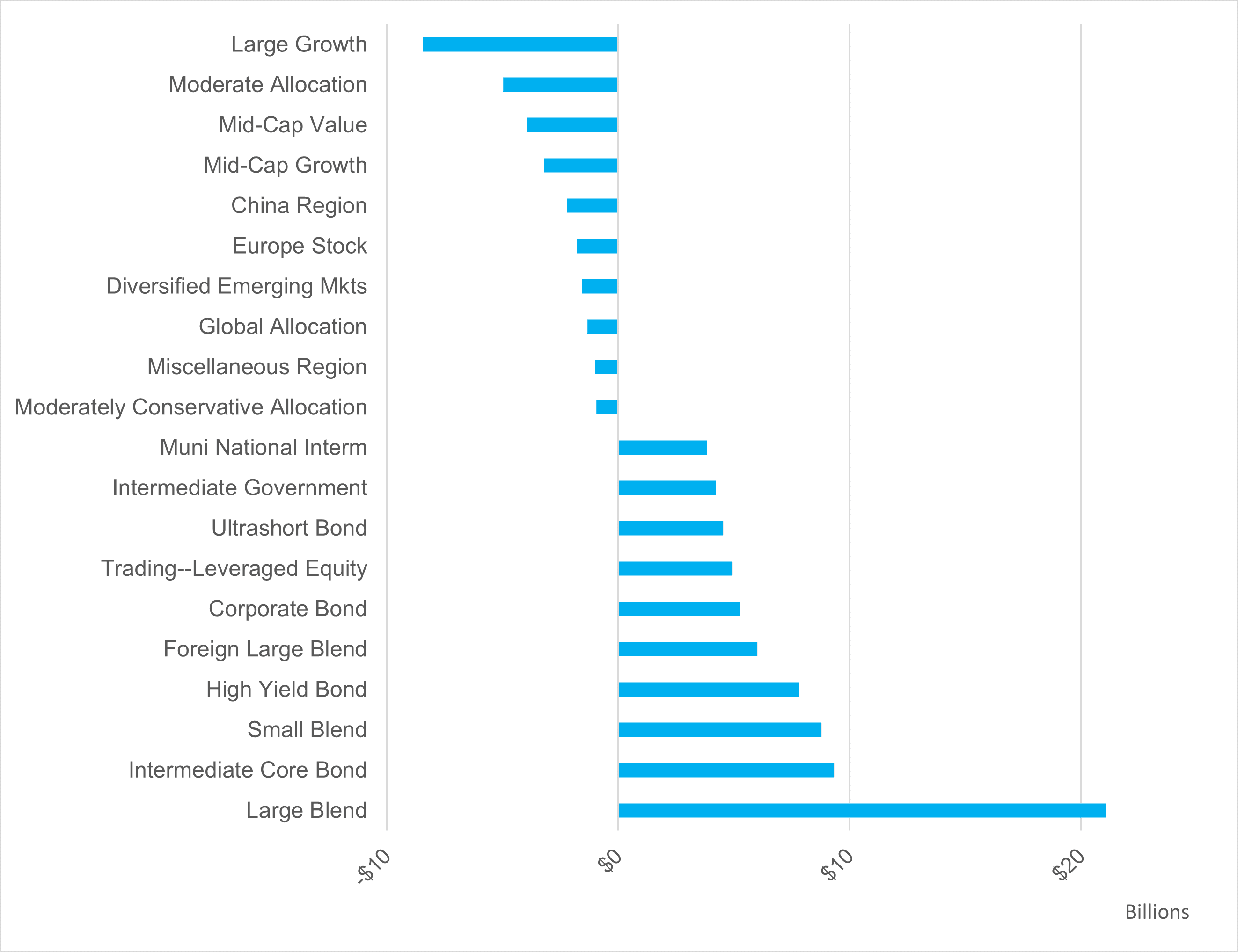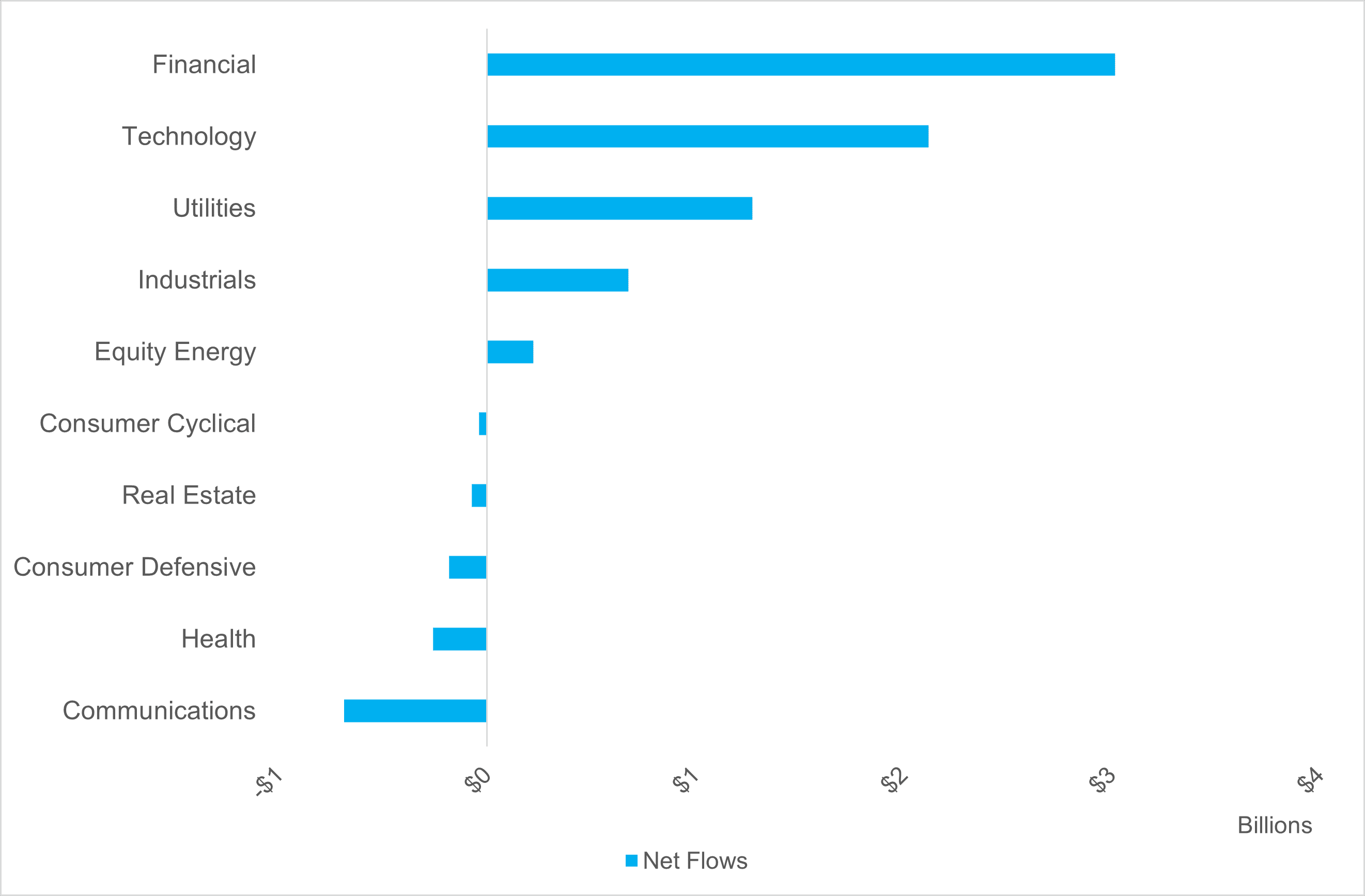Why Financials and Small Caps Dominated July’s Inflows
2024.08.21 02:58
With July behind us, we conducted a deeper dive into fund flows over the last month. Flows measure the net movement of cash into and out of investment vehicles, such as mutual funds and exchange-traded funds (ETF). We analyzed flows to gain insight into investor demand and sentiment surrounding asset classes, sectors, and other classifications of markets.
Morningstar Category Flows
When looking at Morningstar category data in July, large blend equities experienced the largest inflow at $21 billion. This continues a trend we’ve seen this year, as the large blend category is the top category in terms of flows over the trailing year-to-date (YTD) period, experiencing $92 billion in inflows. Following large blend equities, were intermediate core bonds, bringing in $9.3 billion in inflows.
Like large blend equities, intermediate core bonds have been a favorite for investors this year, gaining $78.5 billion in inflows. The third-largest category by flows in July was small blend at $8.8 billion. Small cap strategies have largely lost assets YTD but have flipped to net positive following a stellar performance in July, with small caps, as measured by the , up over 10%, outpacing large caps by roughly 8.5%.
Looking at the other end of the spectrum, large growth funds experienced the largest net outflow in July of $8.5 billion. This also continues a trend seen YTD, as large growth funds have been the sixth largest category by outflows, losing $14.1 billion. Moderate allocation is the next largest category by outflows, losing $5 billion in assets.
Like large growth, moderate allocation funds have seen their assets shrink significantly YTD, ranked as the second largest category by outflows over this period. Following large growth and moderate allocation funds were mid-cap value and mid-cap growth, losing $3.9 billion and $3.2 billion, respectively, in July.
Despite strong performance in July, investors continued to favor the top and bottom ends of the market capitalization (cap) spectrum, with large blend and small blend strategies representing the first and third largest categories by inflows. Mid-cap growth also happens to be the largest category by outflows YTD ($20.3 billion), with mid-cap value not far behind in fifth ($14.5 billion).
Small Caps Saw Significant Inflows in July Following Strong Performance
Trailing 1-Month Net Asset Flows Top Ten and Bottom Ten Across Morningstar Categories (AUM, Billions $)

Source: LPL Research, Morningstar Direct, 08/20/24
Sector Flows
When looking at individual equity sector data in July, the financials sector reported the largest inflows, gaining $3 billion. Financials gained 6.4% in July, making them the second-best performer over the month, highlighting investors who may be chasing performance. Financial inflows in July also continued a trend seen YTD, as the sector has been the second-largest by inflows, gathering $3.2 billion.
Following financials is technology, gaining $2.1 billion as investors continue to pile into megatrends such as artificial intelligence (AI) and cloud computing. Technology has outpaced all other sectors YTD by a significant margin, capturing $19.2 billion in inflows, roughly $16 billion more than financials. Utilities, industrials, and energy round out those sectors that finished July with net inflows, with industrials being the only other sector (technology and financials) that has experienced net inflows YTD ($2.7 billion).
Conversely, communications experienced the largest outflow in July at $687 million. The communications sector only rose 0.2% over the month, making it the second worst-performing sector. Following communications was the healthcare sector, which continues a trend seen in prior months. Healthcare remains the top sector by outflows YTD, losing $259 million in July and $10.2 billion this year. Other sectors that experienced outflows include consumer staples, real estate, and consumer cyclicals. These sectors also remain net negative YTD.
Financials Lead the Way in July Flows
Trailing YTD Net Asset Flows across Morningstar Sectors (AUM, $ Billions)
Source: LPL Research, Morningstar Direct, 08/20/24
When comparing the latest LPL Research Strategic and Tactical Asset Allocation Committee (STAAC) views with the July flow data, there are a number of similarities. The top asset classes by inflows in July were large blend equities, intermediate core bonds, and small blend equities. The STAAC has a slight overweight to large-cap equities over small, with the tilt coming more from large growth equities than large value.
While large caps are more expensive than small caps from a valuation perspective, earnings power and quality, coupled with impressive technicals, outweigh their relatively steep valuations. In fixed income, the STAAC maintains a neutral duration perspective, favoring fixed income broadly over cash, as the risk-return trade-off is attractive relative to history.
From a sector perspective, the STAAC is neutral on the top sector by inflows, and financials, despite strong performance in July driven by a possible deregulation under a Trump victory scenario and a rebound in regional banks. Credit conditions still appear favorable, as do valuations, while the technical backdrop continues to improve.
The STAAC is overweighting the top sector by outflows, and communications, as investors fled the top-performing sector YTD due to some earnings misses this last month and rich valuations. The STAAC believes there are more tailwinds than headwinds for communications as political advertisement spending is expected to pick up, while valuations now appear attractive, as does the technical setup.
***
Important Disclosures:
This material is for general information only and is not intended to provide specific advice or recommendations for any individual. There is no assurance that the views or strategies discussed are suitable for all investors. To determine which investment(s) may be appropriate for you, please consult your financial professional prior to investing.
Investing involves risks including possible loss of principal. No investment strategy or risk management technique can guarantee return or eliminate risk.
Indexes are unmanaged and cannot be invested into directly. Index performance is not indicative of the performance of any investment and does not reflect fees, expenses, or sales charges. All performance referenced is historical and is no guarantee of future results.
This material was prepared by LPL Financial, LLC. All information is believed to be from reliable sources; however LPL Financial makes no representation as to its completeness or accuracy.
Unless otherwise stated LPL Financial and the third-party persons and firms mentioned are not affiliates of each other and make no representation with respect to each other. Any company names noted herein are for educational purposes only and not an indication of trading intent or a solicitation of their products or services.
Asset Class Disclosures –
International investing involves special risks such as currency fluctuation and political instability and may not be suitable for all investors. These risks are often heightened for investments in emerging markets.
Bonds are subject to market and interest rate risk if sold prior to maturity.
Municipal bonds are subject and market and interest rate risk and potentially capital gains tax if sold prior to maturity. Interest income may be subject to the alternative minimum tax. Municipal bonds are federally tax-free but other state and local taxes may apply.
Preferred stock dividends are paid at the discretion of the issuing company. Preferred stocks are subject to interest rate and credit risk. They may be subject to a call features.
Alternative investments may not be suitable for all investors and involve special risks such as leveraging the investment, potential adverse market forces, regulatory changes, and potential illiquidity. The strategies employed in the management of alternative investments may accelerate the velocity of potential losses.
Mortgage-backed securities are subject to credit, default, prepayment, extension, market, and interest rate risk.
High yield/junk bonds (grade BB or below) are below investment grade securities and are subject to higher interest rate, credit, and liquidity risks than those graded BBB and above. They generally should be part of a diversified portfolio for sophisticated investors.
Precious metal investing involves greater fluctuation and potential for losses.
The fast price swings of commodities will result in significant volatility in an investor’s holdings.








